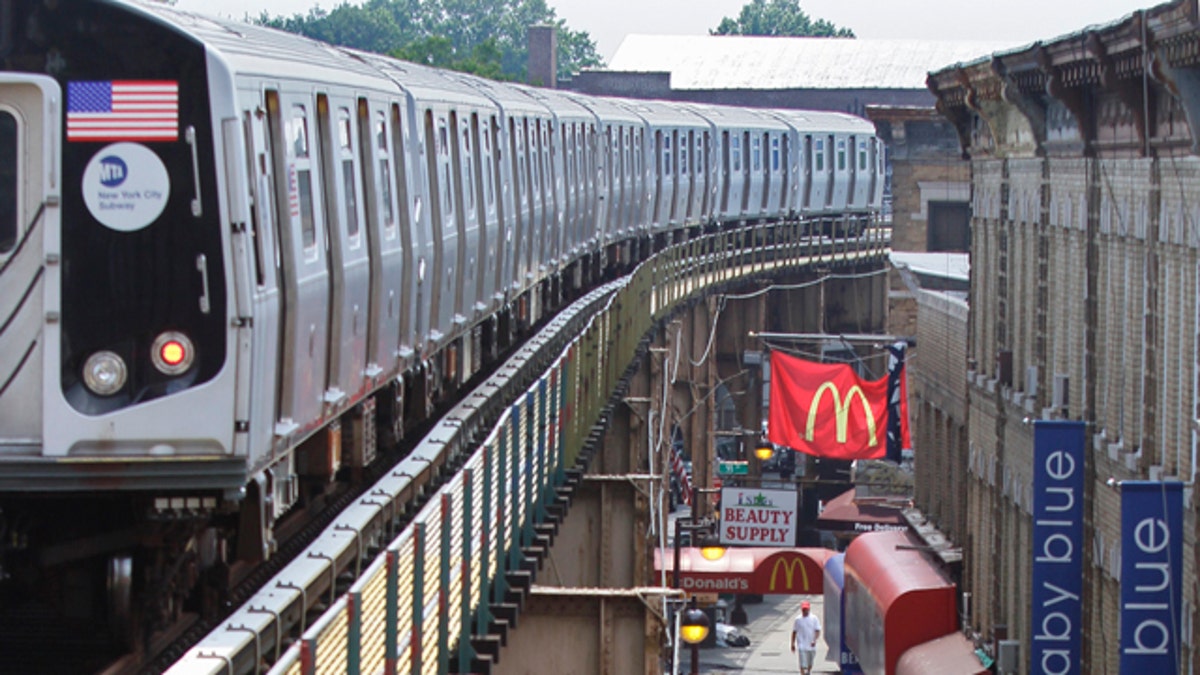
July 7: A subway train in Queens, N.Y. The area, part of former Rep. Anthony Weiner's district, is targeted for redistricting and has become the latest battleground for a Latino organization that is laboring to increase the political clout of Hispanics in Congress. (AP Photo/Bebeto Matthews)
A Latino civil rights organization wants the congressional district of former Rep. Anthony Weiner, who resigned after his sexually-charged messages to various women became public, to be dissolved.
The organization, LatinoJustice PRLDEF, argues that the elimination of Weiner's district presents an opportunity for more minority political empowerment. The 9th District's elimination, supporters of the idea believe, would mean expansion of neighboring districts and increased likelihood that black and Latino incumbents can protect their seats.
"Weiner's departure presents probably the best opportunity to not only shore up the Latino and African American representation, but to do so with the least disruption," said Juan Cartagena, president and general counsel of LatinoJustice PRLDEF.
LatinoJustice PRLDEF, which is involved in redistricting fights in 10 jurisdictions throughout the Northeast and in Florida, is making it proposal as the nation's political map is redrawn to reflect population shifts based on new census data. But such a proposal could irk Democratic leaders and even residents of Weiner's former district themselves.
New York is losing two seats in the U.S. House of Representatives as a result of redistricting, a politically complex and contentious process. The 2010 census showed the state's population grew more slowly than the rest of the country. Hispanics were the only one of three major ethnic groups that grew — by 19 percent.
That means each of the new 27 congressional districts must have 717,707 people; but most currently have about 660,000. Each district has to expand in some direction — how is the question.
Cartagena said allowing neighboring districts to absorb portions of the 9th District will cause the least geographic and political disruption, because those districts will grow but stay roughly the same shape as they are now. Current districts with large Hispanic and black populations will retain their representation and incumbents will be able to protect their seats more easily.
"Eliminating Weiner's district would allow us to mitigate the effect of demographic change and gentrification," Cartagena said in an e-mail. He explained that it would allow surrounding districts to shift "somewhat eastwards."
The growth of Hispanics in the state overall, Cartagena said, is reason enough to call for protecting and even expanding their representation through the redistricting process that each state must undergo to redraw its congressional lines.
"I'm not asking for a handout," Cartagena said. "I'm asking for a recognition of the demographic reality."
Overall, Weiner's old district is mostly white. But data from the U.S. Census shows a 27 percent growth in the Hispanic population in the 9th Congressional District between 2000 and 2010, and a drop of 10 percent in the white population, according to an analysis done by the Cornell Program on Applied Demographics. Also significant was the growth in the black population of 13 percent and Asians at 29 percent.
According to the 2010 U.S. Census, there were 376,576 people who said they were white in the district; 122,654 who identified themselves as Asian; 113,658 who identified themselves as Hispanic; and 29,310 who said they were black.
A plan to dissolve the 9th District could face opposition from Democrats and the candidate they have picked for the special election to fill the seat. Weiner, who had represented the district since 1999, resigned June 16 after acknowledging he sent lewd images of himself to women over the Internet. Queens and Brooklyn Democratic parties have chosen Assemblyman David Weprin, 55, who lives in a neighboring district, to run for the office. He would represent the district through 2012.
The winner of that race could still lose his or her job, depending on the redistricting outcome. Gov. Andrew Cuomo is proposing to throw out the current process of drawing election districts — in which majority parties decide lines to safeguard and expand their majorities — with an independent commission.
"We're not commenting on any speculation of redistricting," said Evan Stavisky, a strategist for Weprin, on Friday after the candidate signed paperwork accepting the party's nomination. "What I can say conclusively is, David Weprin is out talking to his neighbors and talking to people in Queens about his candidacy."
Assemblyman Jack McEneny, an Albany Democrat and his party's leader on redistricting, said it is too early to tell what might happen with the 9th District.
"The whole map has to be done before you know where you are," he said.
Robert Ward, deputy director of the Nelson A. Rockefeller Institute of Government at the University of Albany, said it is no surprise that ethnic groups, such as Hispanics, might feel under-represented.
"It's a classic example of different groups looking for their share of their overall legislative pie," Ward said of LatinoJustice's proposal. "The Hispanics are becoming a significantly larger share of the state's population. The question is, should any ethnic group be mathematically represented ... in proportion to its share of the population?"
The 9th District is a snapshot of New York City's economic, ethnic and social diversity. Vaguely shaped like a high-top sneaker, it begins in north Queens encompassing middle-class Forest Hills, before thinning out and expanding again to include beachside communities in the south, surrounding the western half of Jamaica Bay.
The hardscrabble, polyglot Woodhaven neighborhood is in the thin middle where some said they were not fond of any proposal to break apart the district.
Hector Duprey stood on the sidewalk under the elevated subway tracks on a recent hot summer day, drinking a barley-malt soda and lamenting what he saw as the perils of redistricting.
His greatest fear was that the political representation that the neighborhood enjoyed under the congressman as part of a smaller district would be diluted if it were to be dissolved and the community belong to a larger district. "If it gets broken up, we become one piece in a bigger pie," said the 50-year-old, originally from Puerto Rico, who was accompanied by two friends on Jamaica Avenue.
He said it didn't matter if their representative was black or Hispanic because the neighborhood is ethnically mixed — and because Weiner demonstrated that an outsider could represent and serve their needs well by getting to know their issues. "Weiner lived in that nice neighborhood in Forest Hills, but he's been down here a lot of times," he said.
John Lewis, 49, who is black, balked at the idea as he was getting his hair trimmed at a barber shop.
"I say leave the districts as they are. Politics play too much of a role sometimes. They complicate things," he said. "There's always some ulterior motive. And it's not for the people."
But Nicole Rhodes, outside a coin-operated laundry with her 5-year-old son, Nasiem, said she did not think one person could represent both Forest Hills and Woodhaven.
"Forest Hills is a completely different neighborhood — socially, economically," said the 28-year-old black woman who works as a hospital nurse on the overnight shift. "It doesn't make sense."
Across the country, Latino advocacy groups are pouring resources into the redistricting fight. There are currently 26 Hispanic members in Congress — two in the Senate and 24 in the House. There are 43 black members of Congress, all in the U.S. House of Representatives.
Arturo Vargas, the executive director of the National Association of Latino Elected and Appointed Officials Educational Fund, said that throughout the country, Latinos have been used by both parties as they seek to redraw district lines. Democrats want to spread Latinos around, while Republicans want to concentrate them.
"Latinos' interest is to find that sweet spot," he said, between both parties. "That is why there needs to be a strong Latino voice in redistricting."
Based on reporting by the Associated Press.
Follow us on twitter.com/foxnewslatino
Like us at facebook.com/foxnewslatino




